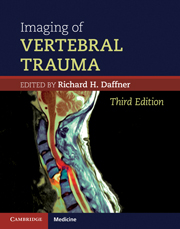Book contents
- Frontmatter
- Contents
- List of contributors
- Preface to the Third Edition
- Preface to the Second Edition
- Preface to the First Edition
- Acknowledgments
- 1 Overview of vertebral injuries
- 2 Anatomic considerations
- 3 Biomechanical considerations
- 4 Imaging of vertebral trauma I: indications and controversies
- 5 Imaging of vertebral trauma II: radiography, computed tomography, and myelography
- 6 Imaging of vertebral trauma III: magnetic resonance imaging
- 7 Mechanisms of injury and their “fingerprints”
- 8 Radiologic “footprints” of vertebral injury: the ABCS
- 9 Vertebral injuries in children
- 10 Vertebral stability and instability
- 11 Normal variants and pseudofractures
- Index
8 - Radiologic “footprints” of vertebral injury: the ABCS
Published online by Cambridge University Press: 21 April 2011
- Frontmatter
- Contents
- List of contributors
- Preface to the Third Edition
- Preface to the Second Edition
- Preface to the First Edition
- Acknowledgments
- 1 Overview of vertebral injuries
- 2 Anatomic considerations
- 3 Biomechanical considerations
- 4 Imaging of vertebral trauma I: indications and controversies
- 5 Imaging of vertebral trauma II: radiography, computed tomography, and myelography
- 6 Imaging of vertebral trauma III: magnetic resonance imaging
- 7 Mechanisms of injury and their “fingerprints”
- 8 Radiologic “footprints” of vertebral injury: the ABCS
- 9 Vertebral injuries in children
- 10 Vertebral stability and instability
- 11 Normal variants and pseudofractures
- Index
Summary
The initial assessment of any patient with suspected vertebral trauma should be by CT or by radiography if CT is unavailable [1]. It is from these studies that the diagnosis is made. Special studies such as MR imaging should be used to delineate the full extent of injury by revealing additional findings not shown on CT or radiographs [1].
Chapter 7 discussed the mechanisms of injury and the radiographic or CT “fingerprints” they produced. This chapter considers the radiologic “footprints” of the injury. Footprints lead you to the injury; fingerprints tell you what kind of injury has occurred and alert you to the possible extent of that injury.
The interpretation of any imaging examination demands that a logical system be followed. I prefer to use the ABCS for evaluating vertebral trauma:
A: alignment and anatomy abnormalities
B: bony integrity abnormalities
C: cartilage (joint) space abnormalities
S: soft tissue abnormalities
This chapter presents a detailed discussion of the various radiographic and CT findings given in the previous chapters and shows how they are integrated in the overall diagnosis of traumatic lesions of the vertebral column. Although many of the comments that follow pertain to the cervical column, the principles apply to all areas. Furthermore, the principles apply to radiographs as well as to CT studies.
- Type
- Chapter
- Information
- Imaging of Vertebral Trauma , pp. 126 - 164Publisher: Cambridge University PressPrint publication year: 2011



